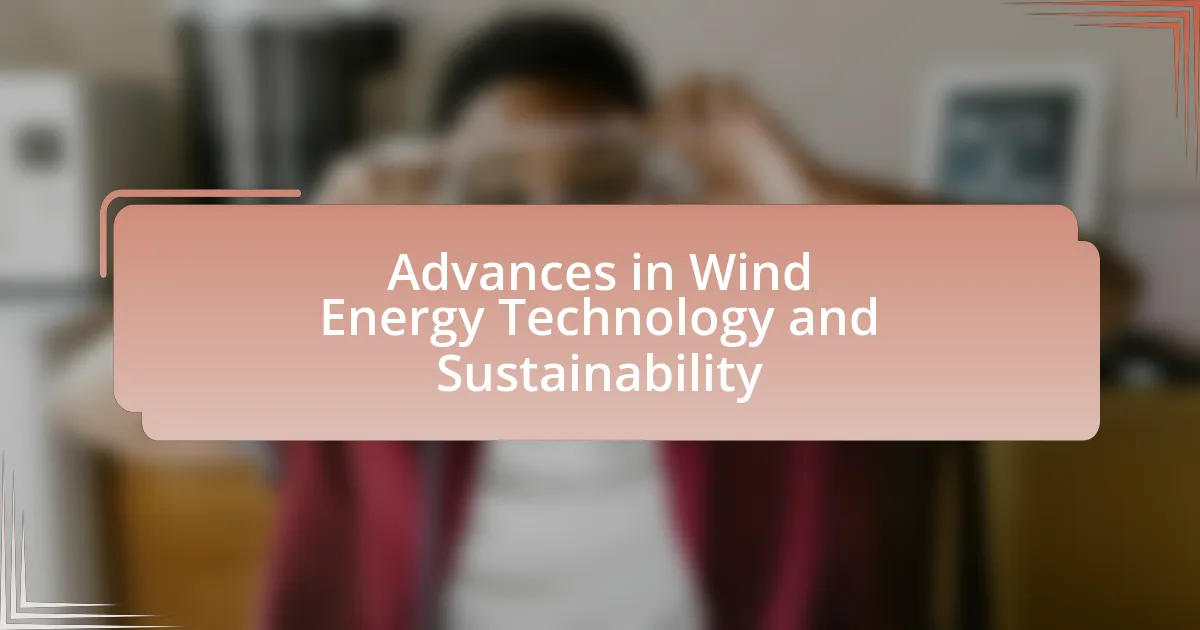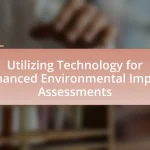The article focuses on recent advances in wind energy technology and its contributions to sustainability. Key developments include the deployment of larger and more efficient turbines, enhanced energy storage solutions, and the integration of artificial intelligence for predictive maintenance. It discusses the evolution of turbine designs, innovations that improve efficiency, and the role of digital technology in optimizing wind farm performance. Additionally, the article examines the latest advancements in offshore wind energy, environmental impacts, and how wind energy compares to other renewable sources. It concludes with insights into future trends and practical steps to maximize wind energy efficiency.
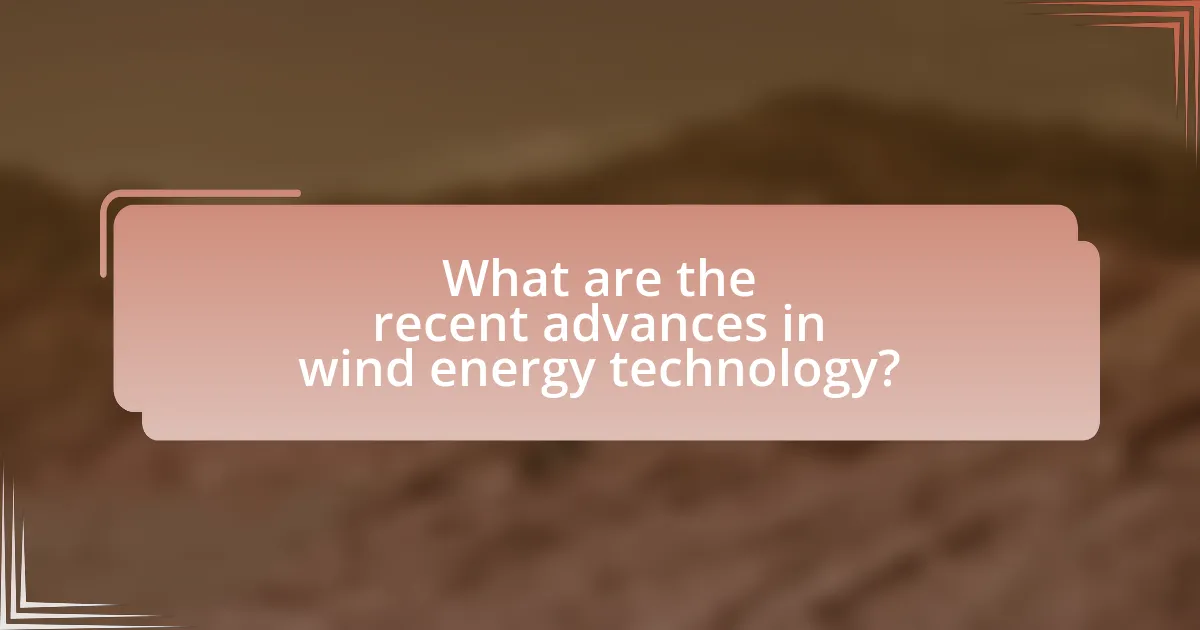
What are the recent advances in wind energy technology?
Recent advances in wind energy technology include the development of larger and more efficient turbines, enhanced energy storage solutions, and the integration of artificial intelligence for predictive maintenance. Larger turbines, such as those exceeding 12 megawatts, have been deployed, allowing for increased energy capture and reduced cost per megawatt-hour. Enhanced energy storage systems, including lithium-ion batteries and pumped hydro storage, improve grid reliability by balancing supply and demand. Additionally, artificial intelligence applications optimize turbine performance and maintenance schedules, leading to reduced operational costs and increased energy output. These advancements collectively contribute to the growing efficiency and sustainability of wind energy systems.
How have turbine designs evolved in recent years?
Turbine designs have evolved significantly in recent years, focusing on increased efficiency, larger rotor diameters, and advanced materials. Modern turbines now feature longer blades that enhance energy capture, with some designs exceeding 80 meters in length, allowing for greater energy production even at lower wind speeds. Additionally, innovations in materials, such as carbon fiber and lighter composites, have reduced weight while maintaining structural integrity, leading to improved performance and durability. Furthermore, the integration of smart technology, including sensors and predictive maintenance systems, has optimized operational efficiency and reduced downtime, contributing to overall sustainability in wind energy production.
What innovations have improved turbine efficiency?
Innovations that have improved turbine efficiency include advanced blade design, variable speed technology, and enhanced materials. Advanced blade design, such as longer and aerodynamically optimized blades, allows turbines to capture more wind energy, increasing their efficiency by up to 20%. Variable speed technology enables turbines to adjust their rotational speed according to wind conditions, maximizing energy capture and reducing mechanical stress. Additionally, the use of lightweight and durable materials, like carbon fiber composites, enhances structural integrity and performance, contributing to overall efficiency improvements. These innovations collectively lead to more effective energy generation in wind turbines.
How do new materials enhance turbine durability?
New materials enhance turbine durability by providing improved resistance to environmental stressors and fatigue. Advanced composites, such as carbon fiber reinforced polymers, offer higher strength-to-weight ratios, allowing turbines to withstand extreme wind conditions without significant wear. Additionally, coatings made from innovative materials can protect turbine components from corrosion and erosion, extending their operational lifespan. Research indicates that turbines utilizing these advanced materials can experience a reduction in maintenance costs by up to 30%, demonstrating their effectiveness in enhancing durability.
What role does digital technology play in wind energy?
Digital technology plays a crucial role in wind energy by enhancing efficiency, optimizing performance, and facilitating predictive maintenance. Advanced data analytics and machine learning algorithms analyze real-time data from wind turbines, allowing operators to optimize energy production based on wind conditions. For instance, the integration of Internet of Things (IoT) devices enables continuous monitoring of turbine performance, leading to improved operational efficiency and reduced downtime. According to a report by the Global Wind Energy Council, digital technologies can increase wind farm productivity by up to 10% through better resource management and predictive analytics.
How is data analytics used to optimize wind farm performance?
Data analytics is used to optimize wind farm performance by analyzing operational data to enhance energy production and reduce maintenance costs. By employing predictive analytics, operators can forecast equipment failures and schedule maintenance proactively, which minimizes downtime. For instance, data from sensors on turbines can be analyzed to identify patterns that indicate wear and tear, allowing for timely interventions. Additionally, real-time data analytics helps in optimizing turbine settings based on wind conditions, leading to improved efficiency. Studies have shown that implementing data-driven strategies can increase energy output by up to 10% and significantly lower operational costs, demonstrating the effectiveness of data analytics in maximizing wind farm performance.
What advancements in control systems have been made?
Recent advancements in control systems for wind energy technology include the development of advanced predictive control algorithms and the integration of machine learning techniques. These innovations enhance the efficiency and reliability of wind turbine operations by optimizing energy output and reducing wear on mechanical components. For instance, predictive control algorithms utilize real-time data to anticipate changes in wind conditions, allowing for proactive adjustments in turbine positioning. Additionally, machine learning models analyze historical performance data to improve fault detection and maintenance scheduling, leading to increased operational uptime. These advancements are supported by studies demonstrating significant improvements in energy capture and operational efficiency in modern wind farms.
What are the latest developments in offshore wind energy?
The latest developments in offshore wind energy include significant advancements in turbine technology, increased capacity, and expanded project approvals. For instance, floating wind turbines are being deployed, allowing for installations in deeper waters where traditional fixed-bottom turbines are not feasible. The global offshore wind capacity reached approximately 46 gigawatts by the end of 2022, with countries like the United Kingdom, China, and the United States leading in new projects. Additionally, the European Union has set ambitious targets to increase offshore wind capacity to 300 gigawatts by 2050, reflecting a strong commitment to renewable energy sources. These developments indicate a robust growth trajectory in the offshore wind sector, driven by technological innovation and supportive policy frameworks.
How do floating wind turbines differ from traditional designs?
Floating wind turbines differ from traditional designs primarily in their installation and operational environments. While traditional wind turbines are typically anchored to the seabed or land, floating wind turbines are mounted on floating platforms that allow them to be deployed in deeper waters where wind resources are often stronger and more consistent. This capability enables access to locations that are not feasible for fixed-bottom turbines, thus expanding the potential for wind energy generation. According to the International Energy Agency, floating wind technology can harness wind energy at depths greater than 60 meters, significantly increasing the available sites for wind farms and enhancing overall energy production efficiency.
What are the environmental impacts of offshore wind farms?
Offshore wind farms have several environmental impacts, both positive and negative. They contribute to reducing greenhouse gas emissions by providing renewable energy, which helps mitigate climate change. However, the construction and operation of these farms can disrupt marine ecosystems, affecting fish populations and seabird habitats. Studies indicate that the installation of wind turbines can lead to changes in local hydrodynamics and sediment transport, potentially impacting marine life. Additionally, noise generated during construction may affect marine mammals. Overall, while offshore wind farms play a crucial role in sustainable energy production, careful planning and monitoring are essential to minimize their ecological footprint.
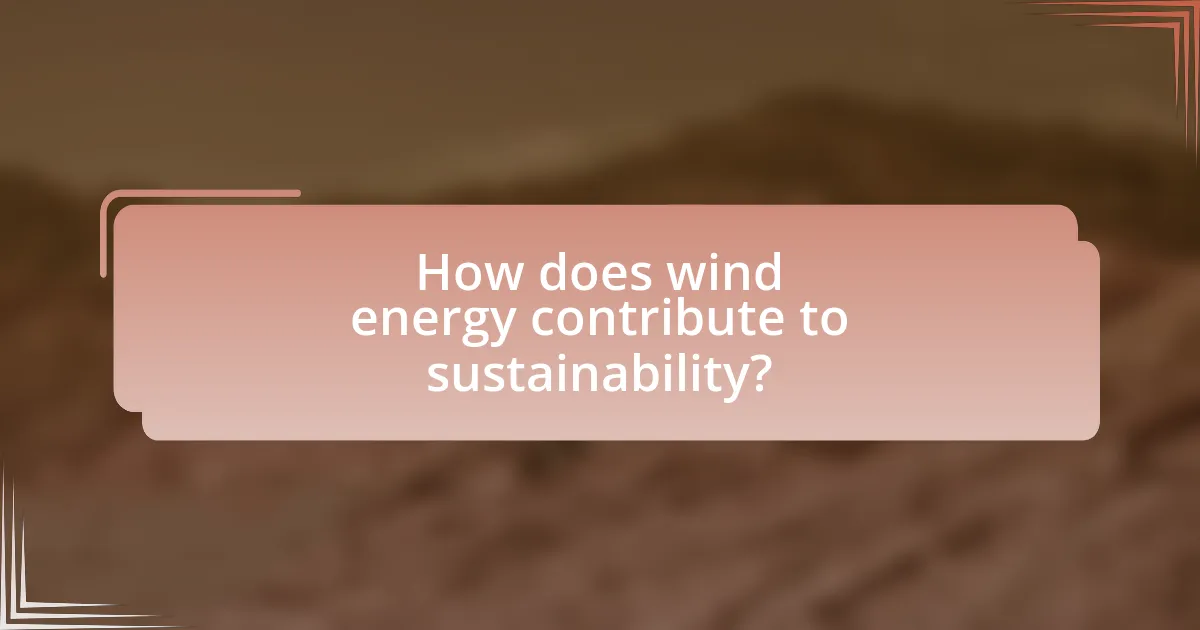
How does wind energy contribute to sustainability?
Wind energy contributes to sustainability by providing a renewable source of electricity that reduces greenhouse gas emissions. Unlike fossil fuels, wind energy generation does not produce carbon dioxide during operation, which is crucial for mitigating climate change. According to the U.S. Department of Energy, wind energy has the potential to displace over 329 million metric tons of carbon dioxide emissions annually, equivalent to the emissions from 70 million cars. This significant reduction in emissions supports global efforts to achieve sustainability goals and combat environmental degradation.
What are the environmental benefits of wind energy?
Wind energy offers significant environmental benefits, primarily by reducing greenhouse gas emissions. Unlike fossil fuels, wind energy generation produces no direct carbon dioxide or other harmful pollutants during operation, which helps mitigate climate change. According to the U.S. Department of Energy, wind energy can reduce carbon emissions by approximately 329 million metric tons annually, equivalent to the emissions from 70 million cars. Additionally, wind energy contributes to improved air quality by decreasing reliance on coal and natural gas, which are major sources of air pollutants. Furthermore, wind farms require less water compared to conventional power plants, conserving vital water resources in arid regions. Overall, the adoption of wind energy plays a crucial role in promoting a cleaner and more sustainable environment.
How does wind energy reduce greenhouse gas emissions?
Wind energy reduces greenhouse gas emissions by generating electricity without burning fossil fuels. Unlike coal or natural gas power plants, wind turbines convert kinetic energy from wind into electrical energy, producing no direct emissions during operation. According to the U.S. Department of Energy, wind energy has the potential to displace over 329 million metric tons of carbon dioxide annually, equivalent to the emissions from 70 million cars. This significant reduction in reliance on fossil fuels directly contributes to lower greenhouse gas emissions, thereby mitigating climate change impacts.
What impact does wind energy have on biodiversity?
Wind energy can have both positive and negative impacts on biodiversity. On the positive side, wind energy reduces greenhouse gas emissions, which helps mitigate climate change and its associated threats to ecosystems. A study published in the journal “Nature Climate Change” indicates that transitioning to renewable energy sources like wind can significantly lower the risks to biodiversity caused by climate change. However, wind turbines can also pose risks to wildlife, particularly birds and bats, which may collide with turbine blades. Research from the U.S. Fish and Wildlife Service shows that wind energy facilities can lead to fatalities among avian species, particularly in areas with high bird migration routes. Therefore, while wind energy contributes to environmental sustainability, careful site selection and technological advancements are necessary to minimize its negative effects on biodiversity.
How does wind energy compare to other renewable sources?
Wind energy is one of the most efficient renewable energy sources, often outperforming solar and hydroelectric power in terms of energy conversion efficiency. Wind turbines can convert approximately 35-45% of the wind’s kinetic energy into electricity, while solar panels typically convert around 15-20% of sunlight into electricity. Additionally, wind energy has a lower land footprint compared to solar farms, allowing for dual land use, such as agriculture alongside turbine installations. According to the U.S. Department of Energy, wind energy capacity has increased significantly, with the U.S. generating over 9% of its electricity from wind in 2021, showcasing its growing role in the renewable energy landscape.
What are the advantages of wind energy over solar energy?
Wind energy has several advantages over solar energy, primarily in terms of efficiency and land use. Wind turbines can generate electricity at a higher capacity factor, often exceeding 40%, compared to solar panels, which typically operate at around 15-20% capacity factor. This means wind energy can produce more electricity consistently over time. Additionally, wind farms require less land per unit of energy produced compared to solar farms, allowing for more efficient use of space. For instance, a study by the National Renewable Energy Laboratory found that wind energy can produce up to 50 times more energy per acre than solar energy.
How does wind energy contribute to energy independence?
Wind energy contributes to energy independence by reducing reliance on imported fossil fuels. By harnessing local wind resources, countries can generate their own electricity, which decreases vulnerability to global energy market fluctuations. For instance, in 2020, the United States produced over 20% of its electricity from wind, significantly lowering its dependence on foreign oil and gas. This shift not only enhances national security but also promotes economic stability by keeping energy expenditures within the country.
What challenges does wind energy face in terms of sustainability?
Wind energy faces several challenges in terms of sustainability, primarily related to land use, resource variability, and environmental impact. The installation of wind turbines requires significant land, which can lead to habitat disruption and conflicts with agricultural or residential areas. Additionally, wind energy is inherently variable, as it depends on wind availability, which can affect the reliability of energy supply. Environmental concerns include the impact on bird and bat populations, as studies have shown that turbine collisions can lead to significant mortality rates among these species. For instance, the U.S. Fish and Wildlife Service estimates that wind turbines cause the deaths of hundreds of thousands of birds annually. These factors collectively pose challenges to the long-term sustainability of wind energy as a reliable and environmentally friendly power source.
How do land use and habitat disruption affect sustainability?
Land use and habitat disruption negatively impact sustainability by reducing biodiversity and altering ecosystem services. When land is converted for agriculture, urban development, or energy production, such as wind farms, natural habitats are fragmented or destroyed, leading to a decline in species populations and genetic diversity. For instance, a study published in the journal “Ecological Applications” found that habitat loss can lead to a 50% reduction in species richness in affected areas. This loss of biodiversity undermines ecosystem resilience, making it harder for ecosystems to recover from disturbances and maintain essential functions like carbon storage and water purification. Therefore, sustainable land use practices are crucial to mitigate these effects and promote ecological balance.
What are the economic challenges associated with wind energy projects?
The economic challenges associated with wind energy projects include high initial capital costs, fluctuating energy prices, and the need for substantial infrastructure investment. High initial capital costs can deter investment, as wind farms require significant funding for equipment, installation, and maintenance. Fluctuating energy prices can impact the financial viability of projects, making it difficult for developers to secure long-term contracts. Additionally, the need for substantial infrastructure investment, such as grid upgrades and transportation logistics, can further strain budgets and complicate project implementation. According to the International Renewable Energy Agency, the average cost of onshore wind projects can range from $1,200 to $4,000 per installed kilowatt, highlighting the financial barriers faced by developers.
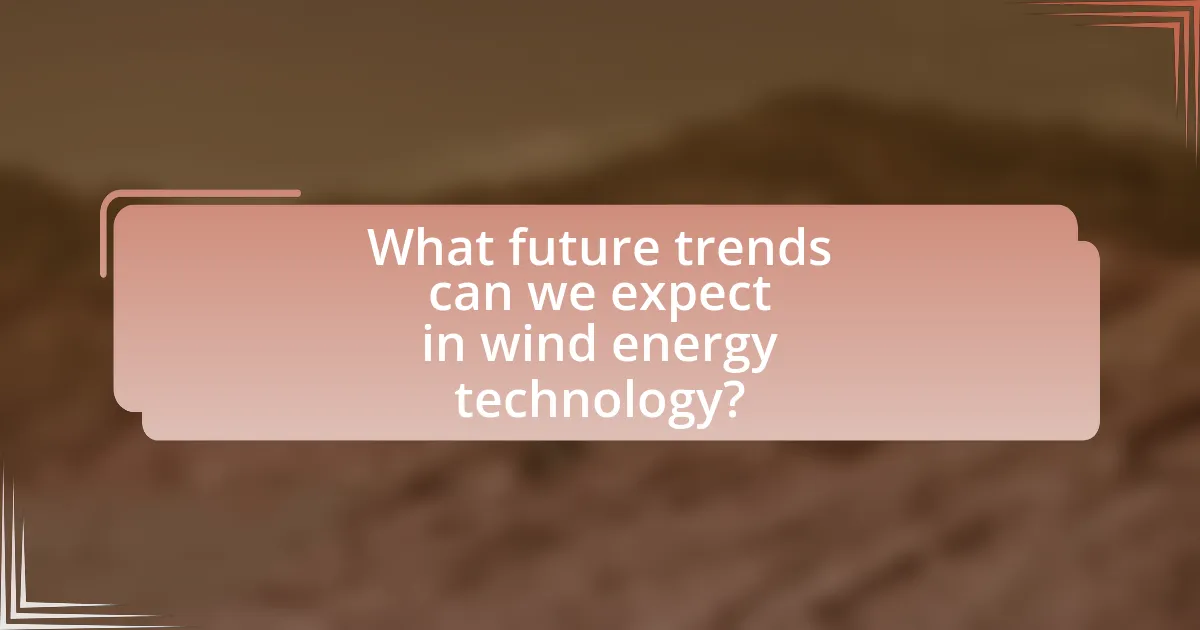
What future trends can we expect in wind energy technology?
Future trends in wind energy technology include the development of larger and more efficient turbines, advancements in energy storage solutions, and the integration of artificial intelligence for optimized performance. Larger turbines, such as those exceeding 12 megawatts, are being designed to capture more wind energy and reduce the cost per megawatt-hour. Energy storage technologies, like lithium-ion batteries and pumped hydro storage, are evolving to address the intermittency of wind energy, enabling better grid integration. Additionally, AI is being utilized to enhance predictive maintenance and operational efficiency, which can lead to reduced downtime and increased energy output. These trends are supported by ongoing research and investment in the sector, indicating a strong trajectory towards more sustainable and efficient wind energy systems.
How will advancements in battery storage impact wind energy?
Advancements in battery storage will significantly enhance the efficiency and reliability of wind energy by enabling better energy management and integration into the grid. Improved battery technologies, such as lithium-ion and solid-state batteries, allow for the storage of excess energy generated during peak wind conditions, which can then be released during low production periods. According to the U.S. Department of Energy, energy storage systems can increase the capacity factor of wind farms by up to 50%, making wind energy a more stable and dependable power source. This integration not only supports grid stability but also facilitates the transition to a renewable energy future by reducing reliance on fossil fuels.
What technologies are being developed for better energy storage?
Technologies being developed for better energy storage include solid-state batteries, flow batteries, and advanced supercapacitors. Solid-state batteries utilize solid electrolytes to enhance energy density and safety, potentially increasing the range and efficiency of electric vehicles and renewable energy systems. Flow batteries, which store energy in liquid electrolytes, offer scalability and long-duration storage, making them suitable for balancing intermittent renewable energy sources like wind. Advanced supercapacitors provide rapid charge and discharge capabilities, ideal for applications requiring quick bursts of energy. These technologies are supported by ongoing research and development efforts aimed at improving efficiency, lifespan, and cost-effectiveness in energy storage solutions.
How does energy storage improve grid reliability with wind energy?
Energy storage improves grid reliability with wind energy by providing a buffer that balances supply and demand fluctuations. Wind energy generation is intermittent, meaning it can vary significantly due to changing weather conditions. Energy storage systems, such as batteries, can store excess energy produced during high wind periods and release it during low production times, ensuring a consistent energy supply. For instance, a study by the National Renewable Energy Laboratory found that integrating energy storage with wind energy can increase grid reliability by reducing the need for backup fossil fuel generation, thereby enhancing overall system stability and resilience.
What innovations are on the horizon for wind turbine technology?
Innovations on the horizon for wind turbine technology include larger turbine designs, advanced materials, and digital optimization techniques. Larger turbines, such as those exceeding 12 megawatts, are being developed to capture more wind energy and improve efficiency. Advanced materials, including lighter and stronger composites, enhance durability and reduce maintenance costs. Digital optimization techniques, utilizing artificial intelligence and machine learning, enable real-time monitoring and predictive maintenance, increasing operational efficiency. These advancements are supported by industry trends indicating a shift towards more sustainable and efficient energy solutions, as evidenced by the Global Wind Energy Council’s report projecting a doubling of global wind capacity by 2025.
How might artificial intelligence enhance wind farm operations?
Artificial intelligence can enhance wind farm operations by optimizing energy production and maintenance processes. AI algorithms analyze vast amounts of data from wind turbines, weather patterns, and energy demand to predict optimal operational settings, leading to increased efficiency. For instance, a study by the National Renewable Energy Laboratory found that AI-driven predictive maintenance can reduce downtime by up to 30%, significantly improving overall productivity. Additionally, AI can facilitate real-time monitoring and decision-making, allowing for immediate adjustments to turbine settings based on changing environmental conditions, thus maximizing energy output and minimizing operational costs.
What potential does vertical-axis wind turbines hold for the future?
Vertical-axis wind turbines (VAWTs) hold significant potential for the future of renewable energy due to their versatility, efficiency in turbulent wind conditions, and lower maintenance requirements compared to traditional horizontal-axis turbines. VAWTs can be installed in urban environments and on rooftops, making them suitable for decentralized energy generation. Research indicates that VAWTs can capture wind from any direction, enhancing their energy output in variable wind conditions. Additionally, advancements in materials and design are expected to improve their efficiency and reduce costs, further promoting their adoption in sustainable energy systems.
What practical steps can be taken to maximize wind energy efficiency?
To maximize wind energy efficiency, implementing advanced turbine designs and optimizing site selection are essential steps. Advanced turbine designs, such as larger rotor diameters and higher hub heights, increase energy capture by harnessing more wind at various speeds. For instance, modern turbines can achieve efficiency rates exceeding 50% under optimal conditions, compared to older models that typically operate below 30%.
Additionally, optimizing site selection involves conducting thorough wind resource assessments to identify locations with consistent and strong wind patterns. According to the National Renewable Energy Laboratory, proper site selection can enhance energy output by up to 20%.
Regular maintenance and the use of predictive analytics for turbine performance monitoring further contribute to efficiency by minimizing downtime and ensuring optimal operation. These practical steps collectively enhance the overall efficiency of wind energy systems.
How can maintenance practices be improved for wind turbines?
Maintenance practices for wind turbines can be improved through the implementation of predictive maintenance strategies that utilize data analytics and condition monitoring technologies. By employing sensors and IoT devices, operators can continuously monitor the health of turbine components, allowing for timely interventions before failures occur. Research indicates that predictive maintenance can reduce downtime by up to 30% and maintenance costs by 25%, as evidenced by a study conducted by the National Renewable Energy Laboratory, which highlights the effectiveness of data-driven approaches in optimizing maintenance schedules and resource allocation.
What best practices should be followed for site selection in wind energy projects?
Best practices for site selection in wind energy projects include conducting thorough wind resource assessments, evaluating environmental impacts, and ensuring proximity to existing infrastructure. Wind resource assessments involve measuring wind speed and direction over time to identify optimal locations for turbine placement, as sites with average wind speeds above 6.5 meters per second are generally considered viable. Environmental impact evaluations assess potential effects on wildlife, habitats, and local communities, adhering to regulations and minimizing ecological disruption. Proximity to infrastructure, such as roads and power lines, reduces costs and logistical challenges associated with construction and maintenance. These practices are supported by studies indicating that careful site selection can enhance energy output and reduce project risks, ultimately contributing to the sustainability of wind energy initiatives.
